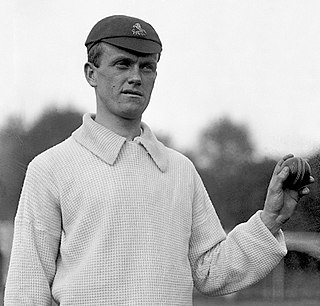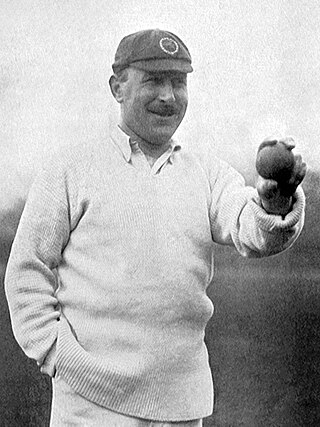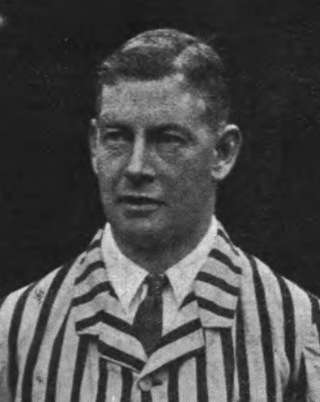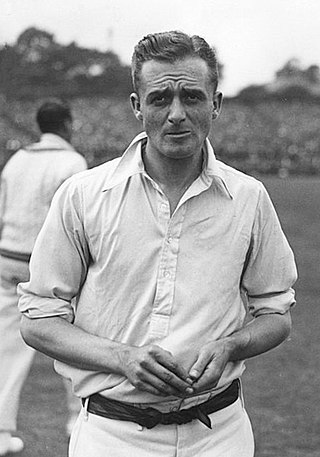Related Research Articles

Sir Leonard Hutton was an English cricketer. He played as an opening batsman for Yorkshire County Cricket Club from 1934 to 1955 and for England in 79 Test matches between 1937 and 1955. Wisden Cricketers' Almanack described him as "one of the greatest batsmen in the history of cricket". He set a record in 1938 for the highest individual innings in a Test match in only his sixth Test appearance, scoring 364 runs against Australia, a milestone that stood for nearly 20 years. Following the Second World War, he was the mainstay of England's batting. In 1952, he became the first professional cricketer of the 20th century to captain England in Tests; under his captaincy England won the Ashes the following year for the first time in 19 years.

Robert William Trevor Key is an English former cricketer and cricket commentator who played international cricket in all formats for England and domestic cricket for Kent County Cricket Club. He is the current managing director of the England Cricket team.

Hedley Verity was a professional cricketer who played for Yorkshire and England between 1930 and 1939. A slow left-arm orthodox bowler, he took 1,956 wickets in first-class cricket at an average of 14.90 and 144 wickets in 40 Tests at an average of 24.37. Named as one of the Wisden Cricketers of the Year in 1932, he is regarded as one of the most effective slow left-arm bowlers to have played cricket. Never someone who spun the ball sharply, he achieved success through the accuracy of his bowling. On pitches which made batting difficult, particularly ones affected by rain, he could be almost impossible to bat against.

Norman Walter Dransfield Yardley was an English cricketer who played for Cambridge University, Yorkshire County Cricket Club and England, as a right-handed batsman and occasional bowler. An amateur, he captained Yorkshire from 1948 to 1955 and England on fourteen occasions between 1947 and 1950, winning four Tests, losing seven and drawing three. Yardley was named Wisden Cricketer of the Year in 1948 and in his obituary in Wisden Cricketers' Almanack, he was described as Yorkshire's finest amateur since Stanley Jackson.

Colin Blythe, also known as Charlie Blythe, was an English professional cricketer who played Test cricket for the England cricket team during the early part of the 20th century. Blythe was a Wisden Cricketer of the Year in 1904 and took more than 2,500 first-class wickets over the course of his career, one of only 13 men to have done so.

Wilfred Rhodes was an English professional cricketer who played 58 Test matches for England between 1899 and 1930. In Tests, Rhodes took 127 wickets and scored 2,325 runs, becoming the first Englishman to complete the double of 1,000 runs and 100 wickets in Test matches. He holds the world records both for the most appearances made in first-class cricket, and for the most wickets taken (4,204). He completed the double of 1,000 runs and 100 wickets in an English cricket season a record 16 times. Rhodes played for Yorkshire and England into his fifties, and in his final Test in 1930 was, at 52 years and 165 days, the oldest player who has appeared in a Test match.

Clement "Clem" Hill was an Australian cricketer who played 49 Test matches as a specialist batsman between 1896 and 1912. He captained the Australian team in ten Tests, winning five and losing five. A prolific run scorer, Hill scored 3,412 runs in Test cricket—a world record at the time of his retirement—at an average of 39.21 per innings, including seven centuries. In 1902, Hill was the first batsman to make 1,000 Test runs in a calendar year, a feat that would not be repeated for 45 years. His innings of 365 scored against New South Wales for South Australia in 1900–01 was a Sheffield Shield record for 27 years. The South Australian Cricket Association named a grandstand at the Adelaide Oval in his honour in 2003 and he was inducted into the Australian Cricket Hall of Fame in 2005.

George Herbert Hirst was a professional English cricketer who played first-class cricket for Yorkshire County Cricket Club between 1891 and 1921, with a further appearance in 1929. One of the best all-rounders of his time, Hirst was a left arm medium-fast bowler and right-handed batsman. He played in 24 Test matches for England between 1897 and 1909, touring Australia twice. He completed the double of 1,000 runs and 100 wickets in an English cricket season 14 times, the second most of any cricketer after his contemporary and team-mate Wilfred Rhodes. One of the Wisden Cricketers of the Year for 1901, Hirst scored 36,356 runs and took 2,742 wickets in first-class cricket. In Tests, he made 790 runs and captured 59 wickets.

Douglas Ward Carr was an English amateur cricketer who played once for the England cricket team in 1909. Carr only began playing first-class cricket in 1909 aged 37 for Kent County Cricket Club. A leg-break bowler who was one of the early proponents of the new googly delivery, he shot to fame in 1909 and enjoyed a short career in the years before the First World War. He was named one of Wisden's five Cricketers of the Year in 1910.

John Thomas Tyldesley was an English cricketer who played first-class cricket for Lancashire and Test cricket for England. He was a specialist professional batsman, usually third in the batting order, who rarely bowled and generally fielded in outfield positions.

Frederick Martin, also known as Fred Martin and Nutty Martin, was an English professional cricketer who bowled left-arm medium-pace spin. Martin played first-class cricket between 1885 and 1892, primarily for Kent County Cricket Club, and appeared twice in Test matches for the England cricket team. He was considered one of the best left-arm spin bowlers in the country between 1889 and 1891.

Arthur Fielder was an English professional cricketer who played as a fast bowler for Kent County Cricket Club and the England cricket team from 1900 to 1914. He played a major role in Kent's four County Championship wins in the years before World War I and toured Australia twice with the England team making six Test match appearances. He was chosen as one of Wisden's Cricketers of the Year in 1907.

George Gibson Macaulay was a professional English cricketer who played first-class cricket for Yorkshire County Cricket Club between 1920 and 1935. He played in eight Test matches for England from 1923 to 1933, achieving the rare feat of taking a wicket with his first ball in Test cricket. One of the five Wisden Cricketers of the Year in 1924, he took 1,838 first-class wickets at an average of 17.64 including four hat-tricks.
Fred Barratt played first-class cricket for Nottinghamshire County Cricket Club from 1914 to 1931 and represented England in five Test matches, one in the home series against South Africa in 1929 and four on the inaugural Test series against New Zealand in the 1929–30 season. He was born in Annesley, Nottinghamshire and died at Nottingham General Hospital, Nottingham.
William Walter Keeton was an English cricketer who played in two Tests in 1934 and 1939. He was a Wisden Cricketer of the Year in 1940 and played first-class cricket as a right-handed opening batsman between 1926 and 1952 for Nottinghamshire. Keeton scored a century against every other first-class county and his 312 not out made in just under eight hours against Middlesex at the Oval in 1939 is still a record for the Nottinghamshire team.
Richard Pollard was an English cricketer born in Westhoughton, Lancashire, who played in four Test matches between 1946 and 1948. A fast-medium right-arm bowler and a lower-order right-handed batsman who made useful runs on occasion, he played for Lancashire between 1933 and 1950, taking 1,122 wickets in 298 first-class matches; he is 10th highest wicket-taker for Lancashire.
Thomas Jayes was an English first-class cricketer who played for Leicestershire between 1903 and 1911. He was born and died at Ratby, Leicestershire. Jayes was a right-arm fast bowler and a hard-hitting lower middle-order right-handed batsman; unusually for fast bowlers of the era when he played, he was also rated as a good fielder.
Kent County Cricket Club's 1906 season was the seventeenth season in which the county competed in the County Championship and saw the county win their first Championship title. Kent played 25 first-class cricket matches during the season, losing only four matches overall and only two matches in the 1906 County Championship. They finished equal on points with Yorkshire and Surrey but won the title on the percentage of finished matches won.
Kent County Cricket Club's 1909 season was the twentieth season in which the County competed in the County Championship. Kent played 30 first-class cricket matches during the season, losing only two matches overall, and won their second Championship title. They finished clearly ahead of second place Lancashire in the 1909 County Championship with the previous years winners Yorkshire in third place.
Kent County Cricket Club's 1910 season was the 21st season in which the County competed in the County Championship. Kent played 29 first-class cricket matches during the season, losing only five matches overall, and won their third Championship title. They finished well ahead of second place Surrey in the 1910 County Championship.
References
- 1 2 Pardon S (1910) English cricketers: dissatisfied and disappointed – Notes by the Editor, Wisden Cricketers' Almanack , 1910. Retrieved 1 June 2016.
- ↑ Chronology of cricket, 1900–1909, Bloomsbury Publishing. Retrieved 1 June 2016.
- ↑ History of the International Cricket Council Archived 27 March 2015 at the Wayback Machine , International Cricket Council. Retrieved 1 June 2016.
- ↑ The Australians in England, 1909, Wisden Cricketers' Almanack , 1910. Retrieved 1 June 2016.
- ↑ England v Australia 1909 – First Test Match, Wisden Cricketers' Almanack , 1910. Retrieved 1 June 2016.
- ↑ England v Australia 1909 – Third Test Match, Wisden Cricketers' Almanack , 1910. Retrieved 1 June 2016.
- ↑ England v Australia 1909 – Fifth Test Match, Wisden Cricketers' Almanack , 1910. Retrieved 1 June 2016.
- ↑ Douglas Carr – Cricketer of the Year 1910, Wisden Cricketers' Almanack , 1910. Retrieved 1 June 2016.
- ↑ Rice J, Renshaw A (2011) 1910, The Wisden Collector's Guide, A&C Black, pp.98–99. Retrieved 19 April 2016.
- ↑ First-class batting and fielding in England for 1909, CricketArchive. Retrieved 1 June 2016.
- ↑ First-class bowling in England for 1909, CricketArchive. Retrieved 1 June 2016.